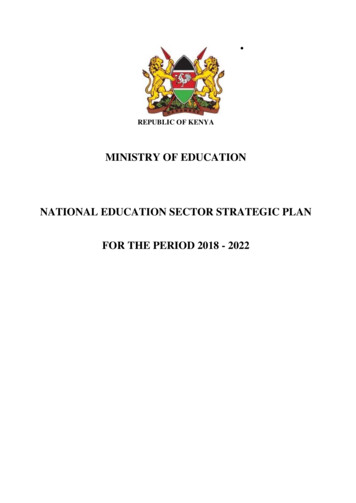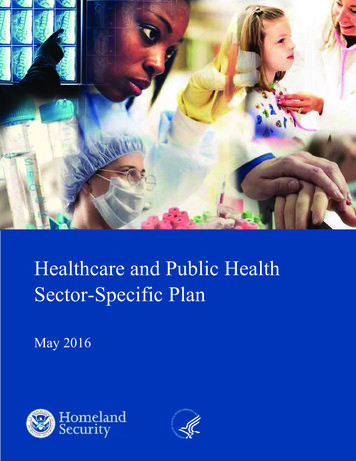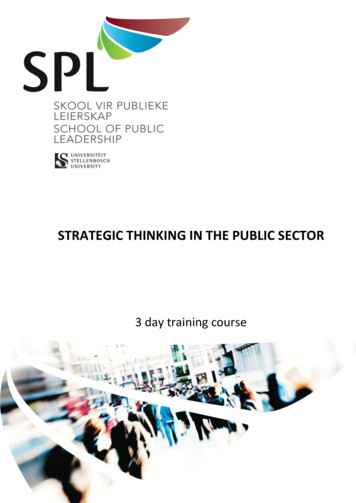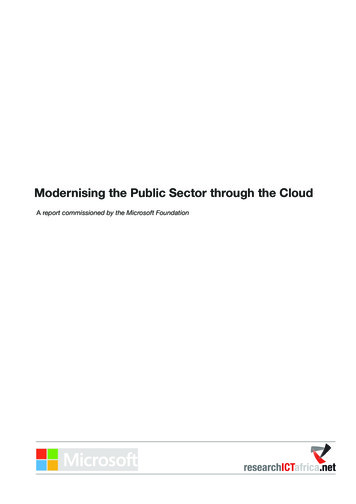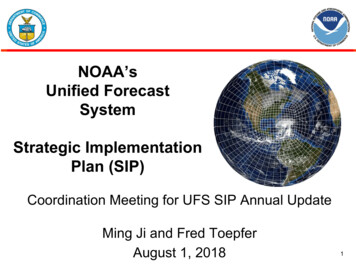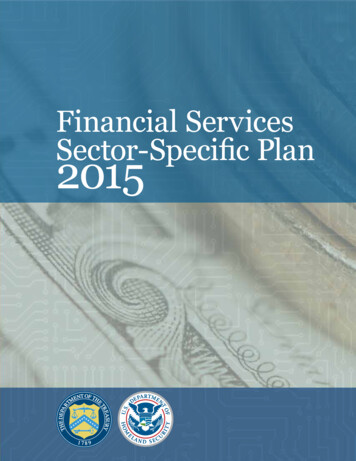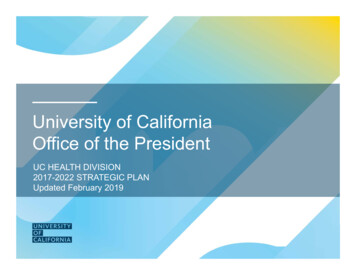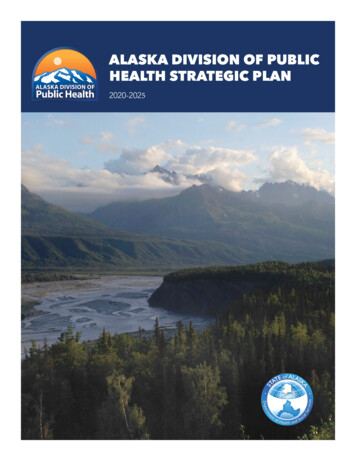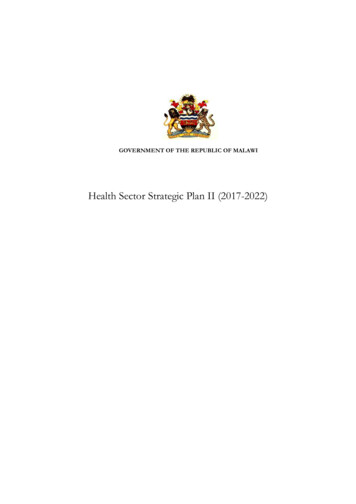
Transcription
GOVERNMENT OF THE REPUBLIC OF MALAWIHealth Sector Strategic Plan II (2017-2022)
Health Sector Strategic Plan IIACKNOWLEDGEMENTSThe Ministry of Health expresses its profound gratitude to all stakeholders that havecontributed the development of the Health Sector Strategic Plan II (2017-2022). Theconcerted efforts of Government institutions, development partners and other healthstakeholders made this possible.We would like to thank partners that funded or provided technical expertise to theprocess: DFID through Options Consultancy for funding thematic analyses, theUniversity of York for funding and providing technical support for EHP revision,USAID for funding HSSP II costing, the World Bank for funding HSSP consultationsand other activities, the WHO regional Office and WHO CHOICE for provide technicalexpertise and data respectively and the Health Services Joint Fund for funding theequipment survey. We would also like to thank all members of the HSSP II Core Teamfor driving the process.Dr Dan NamarikaSecretary for HealthApril 20172
Health Sector Strategic Plan EHPEHRPEMLEmOCEmONCEMSFGDAccident and EmergencyArtemisinin-based Combination TherapyArea Development CommitteeAnnual Implementation PlanAnnual Joint ReviewAntenatal CareAcute Respiratory InfectionsAntiretroviral TherapyBehaviour Change CommunicationBasic Emergency Obstetric and Neonatal CareBasic Health PackageBurden of DiseaseBlood pressureCommunity Based Home Based CareCenter for Disease Control and PreventionCase Detection RateComprehensive Emergency Obstetric and Neonatal CareCentral HospitalChristian Health Association in of MalawiCommunity Health Sciences UnitCommunity Health WorkerCentral Monitoring and Evaluation DepartmentChild Mortality RateCentral Medical Stores TrustCollege of MedicineContraceptive Prevalence RateCivil Society OrganisationDisability Adjusted Life YearDistrict CommissionersDistrict Executive CommitteeDepartment for International DevelopmentDistrict Health Management TeamDepartment of Human Resource Management and DevelopmentDistrict Health OfficerDemographic and Health SurveyDistrict Implementation PlanDepartment of Disaster Preparedness Management AffairsDirectly Observed Treatment, Short Course (for Tuberculosis)Department of Public Sector ManagementDiphtheria, Pertussis and TetanusEnvironmental HealthEssential Health PackageEmergency Human Resource PlanEssential Medicines ListEmergency Obstetric CareEmergency Obstetric and Neonatal CareEssential Medicines and SuppliesFocus Group Discussion3
Health Sector Strategic Plan HHRMISHSAHSCHSSHSSPHSWGHTCICTIECIFMISIHDIHP MBTSMCHMDG(s)MDRMGDSMICSGender-based violenceGross Domestic ProductGlobal Fund for the Fight against AIDS, Tuberculosis and MalariaGovernment of MalawiGroup Village HeadmanHealth Centre Advisory CommitteeHealth Centre Management CommitteeHealth Care WorkerHealth Development PartnersHealth Education UnitHealth Information SystemHealth Management Information SystemHuman PapillomavirusHuman ResourcesHuman Resources for HealthHuman Resources Management Information SystemHealth Surveillance AssistantHealth Services CommissionHealth Systems StrengtheningHealth Sector Strategic PlanHealth Sector Working GroupHIV Testing and CounsellingInformation and Communication TechnologyInformation Education and CommunicationIntegrated Financial Management Information SystemIschaemic Heart DiseaseInternational Health Partnerships and other InitiativesIntegrated Management of Childhood IllnessInfant Mortality RateInternational Public Sector Accounting StandardsIntermittent Preventive TreatmentIndoor Residual SprayingInformation TechnologyInsecticide Treated NetsJoint Assessment of National Strategic PlansJoint Annual ReviewKamuzu College of NursingLymphatic filariasisLonger Lasting Insecticide Treated NetLogistics Management Information SystemLower Respiratory InfectionsMonitoring and EvaluationMalawi Blood Transfusion ServiceMaternal and Child HealthMillennium Development Goal(s)Multi Drug ResistantMalawi Growth and Development StrategyMultiple Indicators Cluster Survey4
Health Sector Strategic Plan QAQMRHRTARUMSBCCSDPMaternal Mortality Ratio/RateMinistry of Education, Science and TechnologyMinistry of FinanceMinistry of HealthMinistry of Local Government and Rural DevelopmentMemorandum of UnderstandingMember of ParliamentMother To ChildMedium Term Expenditure FrameworkMalawi Traditional Healers Umbrella OrganizationMedium Mid-Term ReviewMid-Year ReviewNational Audit OfficeNon-Communicable DiseaseNational Commission for Science and TechnologyNational Drug PolicyNon-Governmental OrganizationNational Health AccountsNational Health Sciences Research CommitteeNational Local Government Finance CommitteeNeonatal Mortality RateNational Public Health InstituteNational Statistical OfficeNeglected Tropical DiseasesOffice of the Director of Public ProcurementOpportunistic InfectionOffice of the President & CabinetOral Rehydration SolutionOral Rehydration TherapyPhysical Assets ManagementPerformance-Based ManagementPublic Expenditure and Financial AccountabilityPublic Financial ManagementParticipatory Sanitation And Hygiene TransformationPrimary Health CarePublic Health Institute of MalawiPublic Health LaboratoryPeople Living with HIVPrevention of Mother to Child Transmission of HIVPost Natal CareProgram of WorkPublic Private PartnershipQuality AssuranceQuality ManagementReproductive HealthRoad Traffic AccidentsRational Use of MedicinesSocial Behaviour Change CommunicationService Delivery Point5
Health Sector Strategic Plan NFPAUNICEFUSAIDVDCVHVHCWASHWHOWHSZHSOSocial Health InsuranceService Level AgreementSenior ManagementStandard Operating ProceduresSexual and Reproductive HealthSoil Transmitted HelminthsSexually Transmitted InfectionSector Wide ApproachTechnical AssistanceTraditional AuthorityTraditional Birth AttendantTotal Fertility RateTerms of ReferenceTechnical Working GroupUnder Five Mortality RateUnited Nations Population FundUnited Nations Children’s FundUnited States Agency for International DevelopmentVillage Development CommitteeVillage HeadmanVillage Health CommitteeWater, Sanitation and HygieneWorld Health OrganizationWorld Health SurveyZonal Health Support Office6
Health Sector Strategic Plan IIFOREWORDThe Government of Malawi is committed to ensuring that people in Malawi attain thehighest possible level of health and quality of life. This will be achieved by ensuringuniversal coverage of basic health care which is the obligation of Government accordingto the Republican constitution but also an important area for investment by developmentpartners, private institutions and other organisations due to its catalytic effect to theeconomic sector.HSSP II development started at an opportune time when the Millennium DevelopmentGoals (MDGs) had just ended and the Sustainable Development Goals were launched.The HSSP II therefore incorporates the SDG agenda and builds on the attainment ofMDGs 4 and 6, reducing child mortality and combating HIV and AIDS, Malaria andother diseases respectively; reduction in maternal mortality and; high coverage of certainkey interventions such as skilled attendance at birth and immunisation. The HSSP II hasused latest evidence and methods to revise a Basic Health Package that is more realisticthan its predecessor packages and helps the public health sector to achieve higher totalpopulation health, increase financial risk protection and client satisfaction with healthcare.It is well known that health care provision in Malawi is highly dependent on externalfinancing. The HSSP II has therefore focussed on strengthening governance of thehealth sector in order to improve efficiency and get the maximum out of existingresources i.e. human, financial and material. The HSSP II has also put to the foreexploration of domestic financing mechanisms, although it is still envisaged thatdevelopment aid to the health sector will be critical to sustain the gains made. Wetherefore look forward to continued support from our development partners.As a strategic document that we have jointly formulated, it is my sincere hope that it willhenceforth become the single most important point of reference for design of servicedelivery programmes, resource mobilization and health financing, as it embodies ourdream for a better health care delivery system for all the people of Malawi.7
Health Sector Strategic Plan IIEXECUTIVE SUMMARYThe Health Sector Strategic Plan II (HSSP II) 2017-2022 is the health sector’s mediumterm strategic plan outlining objectives and activities and guiding resources over theperiod 2017-2022. It succeeds the HSSP I (2011-2016). The aim of the HSSP II buildson the successes achieved under the previous plan while addressing areas where targetswere not met and progress slow.Under the HSSP I Malawi made substantial health gains. HSSP I targets for Under-5mortality and infant mortality were surpassed, 63/1000 live births against a target of78/1000 livebirths for the former and 42/1000 livebirths against a target of 45/1000 forthe latter. There was also a steady decline in the maternal mortality ratio (MMR), whichwas estimated at 439/100,000 live births in 2016, down from 675/100,000 in 2010.Despite the progress, Malawi’s MMR and neonatal mortality rate (NMR) are among thehighest in Sub-Saharan Africa. The HIV prevalence among women and men age 15-49age decreased between 2010 and 2015-16 from 10.6% CI [9.6%-11.6%] to 8.8%, CI[8.0%-9.5%].The gains in health outcomes could partially be attributed to increased utilisation of somekey services such as skilled attendance at birth which was estimated at 90% in 2016 andthe percentage of pregnant women making at least one ANC visit during pregnancy was95%. On the other hand, only 24% of pregnant women had their first ANC visit in thefirst trimester; only 51% had four or more ANC visits and only 42% of women and 60%of new-borns received a postnatal check 48 hours of birth. Median coverage of basicvaccinations reached as high as 95% although there was a decline in the percentage ofchildren aged 12-23 months were fully immunized from 81% in 2010 to 71.3% in 2016.There was mixed progress with regard to development of health systems. The MoHpromoted a total of 2,438 staff to more senior positions in the 2014/2015 fiscal year(FY), across many cadres. These promotions however did not extend to health staffworking in CHAM facilities, which has created inequities across the workforce. There isstill a vacancy rate of 45%, however. During the HSSP I period, a total of 12 new healthfacilities (1 district hospital and 11 health centres) were constructed. The proportion ofthe population living within 8 km radius of health facility, however, declined from 81%in 2011 to 76% in 2016. This indicates that there is still a significant proportion of thepopulation that is underserved, especially those residing in the rural and hard to reachareas.The health care system experienced regular shortages of essential medical products andtechnologies. This was due to many factors including inadequate funding, weak supplychain management, irrational use of medicines and leakage and pilferage. In 2015/16 FY,only an average of 24% of health facilities could maintain enough stocks to cover 1 to 3months for the 23 HSSP I tracer medicines and medical supplies against a national targetof 60%. For health information systems, critical milestones were achieved at policy levelincluding development of an eHealth strategy, an approved HIS Policy (October 2015),an updated handbook of national indicators and a HIS operational plan. Challenges stillremain, the key one being the existence of parallel reporting systems which has created8
Health Sector Strategic Plan IIstructural challenges and weakened the mainstream monitoring and evaluation system.There was mixed progress with respect to governance of the health sector over the pastfive years. Weak governance structures resulted in poor coordination.Health care financing in Malawi remains unsustainable and unpredictable. During theperiod 2012/13-2014/15, development partners’ contributions accounted for an average61.6% of total health expenditure (THE), Government accounted for an average of25.5% and households 12.9% of THE. In the HIV/AIDS subsector, donorcontributions average 95% of total financing. Health care financing reforms were henceexplored such as feasibility of a national health insurance scheme and establishment of ahealth fund.Inequalities in health outcomes and health care access persisted during HSSP 1; therewere differences by wealth status, education, gender and geographical location. The 2016MDHS shows, for example, that the prevalence of stunting in children under five years is46% among children in the lowest wealth quintile, 37% among those in the middlewealth quintile and 24% for children in the highest wealth quintile.The HSSP II aims to further improve health outcomes through the provision of a basichealth package (BHP) and health systems strengthening for efficient delivery of the BHP.The goal of the HSSP II is to achieve universal health coverage of quality, equitable andaffordable health care with the aim of improving health status, financial risk protectionand client satisfaction. Objective 1 builds on the successes of the Essential HealthPackage (EHP), which has outlined the health care interventions available to allMalawians, free at the point of access, since 2004. Objective 2 addresses theenvironmental and social risk factors that impact on health care requirements and healthoutcomes. Objectives 3-8 focus on elements of the health system that are required forthe effective, efficient and quality provision of health care interventions, namely humanresources, infrastructure, medical equipment, medicines and medical supplies,information systems, governance and leadership and financing. A primary concept of theHSSP II has been the rationalisation of the health sector’s objectives and activities. Thedesign of the HSSP II has been more realistic than ambitious to ensure that that allobjectives are actually achieved.The five-year cost of the HSSP II is estimated to be USD 3,189 million. Costs increasefrom 629 million in 2017/18 fiscal year (FY) to 646 million in 2021/22. The total costper capita each year ranges from 35 to 37.The HSSP II will be implemented by DHOs, central hospitals, development partners,civil society organisations, Non-Governmental Organisations (NGOs) and other healthstakeholders. It will be monitored and evaluated using a set of indicators separated intonational core health indicators and program level indicators. Routine and survey data willbe used to measure progress. The MoH will work towards a harmonized country-ledM&E framework.9
Health Sector Strategic Plan IITable of ContentsACKNOWLEDGEMENTS . 2ACRONYMS. 3FOREWORD. 7EXECUTIVE SUMMARY . 8List of Tables . 12List of Figures . 131.2.3.4.Introduction . 141.1.1.2.1.3.Situation Analysis . 182.1.2.2.2.3.2.4.2.5.Health Status . 18Service Provision . 20Social Determinants of Health . 25Health Systems. 27Conclusion . 36HSSP II overarching agenda . 373.1.3.2.3.3.3.4.3.5.3.6.3.7.Vision . 37Mission . 37Goal . 37The Sustainable Development Goals . 37National Policy Context . 38Objectives of HSSP II . 38Guiding Principles/Core Values . 39The Basic Health Care Package (BHP) & Basic Health Care Package Plus (BHP )414.1.4.2.4.3.5.Context . 14The Malawi health care system. 15HSSP II development process . 16Introduction . 41Review of the EHP 2004-2016 . 41The Basic Health Care Package (BHP) & Basic Health Care Package Plus (BHP ). 43Strategies for the HSSP II . 525.1.Objective 1: Increase equitable access to and quality of health care services . 525.2.Objective 2: Reduce environmental and social risk factors that have a direct impact onhealth 525.3.Objective 3: Improve the availability and quality of health infrastructure and medicalequipment . 535.4.Objective 4: Improve availability, retention, performance and motivation of humanresources for health for effective, efficient and equitable health service delivery. 5310
Health Sector Strategic Plan II5.5.Objective 5: Improve the availability, quality and utilization of medicines and medicalsupplies 535.6.Objective 6: Generate quality information and make it accessible to all intended usersfor evidence-based decision-making, through standardized and harmonized tools across allprogrammes . 545.7.Objective 7: Improve leadership and governance across the health sector and at alllevels of the health care system . 545.8.Objective 8: Increase health sector financial resources and improve efficiency inresource allocation and utilization . 556.7.HSSP II financing . 566.1.6.2.6.3.Methodology . 56Total resource needs . 56Financial Space. 58Monitoring and evaluation of HSSP II . 597.1.HSSP II Monitoring and Evaluation Tools . 59Annex 1: Public health sector vacancy analysis . 65Annex 2: Objectives, strategies and key activities of the HSSP II . 79Annex 3: HSSP II M&E Framework . 9811
Health Sector Strategic Plan IIList of TablesTable 1: Health Facilities in Malawi . 15Table 2: Status of MDG targets in Malawi AT ENDLINE . 19Table 3: Leading causes of DALYs in Malawi, 2011 . 20Table 4:Prevalence of common Non-Communicable Diseases in Malawi. 24Table 5 Vacancy rate of clinical staff against established position for MoH and CHAM27Table 6: Summary of Health Expenditures during Fiscal Years 2012/13-2014/15 . 32Table 7: list of interventions in BHP . 45Table 8: list of BHP interventions . 48Table 9: HSSP II Costs vs. Fiscal Space . 58Table 10: Performance Review Methods. 59Table 11: Data Sources Required to Report on Indicators . 6212
Health Sector Strategic Plan IIList of FiguresFigure 1: Trends in child health indicators . 18Figure 2: Coverage of basic vaccinations among children age 12-23 months. 22Figure 3: Percentage of children age 12-23 months who received all basic vaccinations 22Figure 4: Major risk factors and their contribution to burden of disease . 26Figure 5: health care financing trends by source. 32Figure 6: Per capita EHP cost and actual per capita health expenditure . 41Figure 7: Trade-off between coverage of package & population coverage . 42Figure 8: Health Benefits Package revision process . 43Figure 10: Framework for Monitoring and Evaluation of HSSP II . 59Figure 11: Malawi National Health Indicators Data Sources. 6113
Health Sector Strategic Plan II1. Introduction1.1. ContextMalawi is a landlocked country with a surface area of 118,484 km of which 94,276 km iswater. Administratively, the country is divided into three regions, namely the northern,central and southern regions. The country has 28 districts, which are further divided intotraditional authorities (TA) ruled by chiefs. The Traditional Authorities are sub-dividedinto villages, which form the smallest administrative units. Politically, each district isdivided into constituencies that are represented by Members of Parliament (MPs) in theNational Assembly and constituencies are divided into wards which are represented bylocal councillors in District Councils.The country has an estimated population of 17.4 million people in 2017 1 with an averageannual growth rate of 2.7%, giving an estimated population of 20.4 million people by2022. An estimated 84% of the population lives in the rural areas as compared to 16% inurban centres. Malawi is predicted to experience an average annual urban populationgrowth rate of 4.2% from 2013 to 2030 2, which will result in an increase in urbanization.Malawi has a young population with 64% of the total population under the age of 15,18% under the age of 5 and only 3% above 65 years. Life expectancy is estimated at 58.4for both sexes in 2017.Malawi’s Gross Domestic Product (GDP) per capita in 2015 was estimated atUSD381.40 3. Real GDP growth for Malawi was reported as 2.9% in 2016 4. The economyis predominantly agro-based, with agriculture and forestry and fishing contributing to28% of GDP 5. Informal employment is higher than formal employment, estimated at89% and 11% respectively 6. The mean and median earnings per month for the totaleconomically active population were estimated at USD114 and USD37, respectively.Development aid plays a key role in the economy and in the health sector it accounts foron average 62% of total funding 7 . In addition, diaspora remittances increasinglycontribute to the country’s economy, estimated at USD34 million in 2015 8.Literacy is higher among men (83%) than women (72%) 9 . The median number ofschooling years completed has increased significantly over time; in 1992 it was estimatedat 0.4 years for women and 4.3 years for men compared with 5.6 years for women and6.6 years for men. This shows that Malawi has also made significant strides in narrowinggender disparities in education. The 2015-16 Malawi Demographic and Health Surveyhas demonstrated increased women empowerment over time by various attributes. Forexample, the percentage of women involved in decisions about their health careincreased from 55% in 2010 to 68% in 2015-16 and women’s involvement in decisionsabout major household purchases increased from 30% to 55% over the same period.National Statistical Office in 2016 Population Projections20153 Audit Report – Global Fund Grants for Malawi – October 20164 National Accounts and Balance of Payments Technical Committee, Ministry of Finance, EconomicDevelopment and National Statistics Office, Sept. 20165 ibid6 The Malawi Labour Force Survey 20137 National Health Accounts for 2012/13-2014/158 World Development Indicators 20179 Malawi Demograhic and Health Survey 2015-201612Unicef14Planning and
Health Sector Strategic Plan II1.2. The Malawi health care systemHealth services in Malawi are provided by public, private for profit (PFP) and private notfor profit (PNFP) sectors. The public sector includes all health facilities under theMinistry of Health (MOH), district, town and city councils, Ministry of Defence, Ministryof Internal Affairs and Public Security (Police and Prisons) and the Ministry of NaturalResources, Energy and Mining (Ministry of Health, 2008b). Public provision of healthcare is enshrined in the republican constitution which states that the State is obliged “toprovide adequate health care, commensurate with the health needs of Malawian society and internationalstandards of health care” (Ministry of Justice, 2006). Health services in the public sector arefree-of-charge at the point of use. The PFP sector consists of private hospitals andclinics. Traditional healers are also prominent and would be classified as PFP. The PNFPsector comprises of religious institutions, non-governmental organisations (NGOs),statutory corporations and companies. The major religious provider is the ChristianHealth Association of Malawi (CHAM) which provides approximately 29% of all healthservices in Malawi (MSPA 2014). Most private and private-not-for-profit providerscharge user fees for their services. Table 1 shows the distribution of health facilities bytype and ownership.Table 1: Health Facilities in MalawiGovernment nic2511Health Post271Total509170Private22522230252NGO2Source: Ministry of Health and ICF International (2014)5052059Company Total0119755807048955369281060Malawi’s health care system is organised at three levels namely: primary, secondary andtertiary. These different levels are linked to each other through an established referralsystem. Primary and secondary level care fall under district councils. The District HealthOfficer (DHO) is the head of the district health care system and reports to the DistrictCommissioner (DC) who is the Controlling Officer of public institutions at district level.1.2.1. Primary levelAt primary level, health services are provided by health surveillance assistants (HSAs) incommunities, health posts, dispensaries, maternity clinics, health centres and communityhospitals. Each HSA is responsible for about 1,000 people and there are currently about11,000 HSAs in post. HSAs mainly provide promotive and preventive health carethrough
Health Sector Strategic Plan II 8 EXECUTIVE SUMMARY The Health Sector Strategic Plan II (HSSP II) 2017-2022 is the health sector's medium term strategic plan outlining objectives and activities and guiding resources over the period 20172022. It - succeeds the HSSP I (20112016)-. The aim of the HSSP II builds
